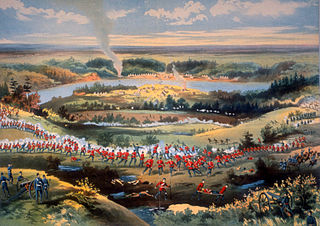
The North-West Rebellion, was an armed rebellion by the Métis under Louis Riel and an associated uprising by Cree and Assiniboine of the District of Saskatchewan, North-West Territories, against the Canadian government. Many Métis felt that Canada was not protecting their rights, their land, and their survival as a distinct people. Fighting broke out in late March, and the conflict ended in June. About 91 people were killed in the fighting that occurred that spring before the conflict ended with the capture of Batoche in May 1885.
The Battle of Frenchman's Butte, fought on May 28, 1885, occurred when the Alberta Field Force attacked a force of Cree, dug in on a hillside near Frenchman's Butte. The battlefield is locared in what was then the District of Saskatchewan of the North-West Territories, now the province of Saskatchewan.

Acheson Gosford Irvine, ISO served as Commissioner of the North-West Mounted Police (NWMP) from November 1, 1880, to March 31, 1886.

The Battle of Duck Lake was an infantry skirmish 2.5 kilometres (1.6 mi) outside Duck Lake, Saskatchewan, between North-West Mounted Police forces of the Government of Canada, and the Métis militia of Louis Riel's newly established Provisional Government of Saskatchewan. The skirmish lasted approximately 30 minutes, after which Superintendent Leif Newry Fitzroy Crozier of the NWMP, his forces having endured fierce fire with twelve killed and eleven wounded, called for a general retreat. The battle is considered the initial engagement of the North-West Rebellion. Although Louis Riel proved to be victorious at Duck Lake, the general agreement among historians is that the battle was strategically a disappointment to his cause.
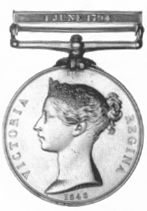
The Naval General Service Medal (NGSM) was a campaign medal approved in 1847, and issued to officers and men of the Royal Navy in 1849. The final date for submitting claims was 1 May 1851. Admiral Thomas Bladen Capel was one of the members of the board that authorised the medal.

The Military General Service Medal (MGSM) was a campaign medal approved in 1847 and issued to officers and men of the British Army in 1848.

The India General Service Medal was a campaign medal approved on 1 March 1854, for issue to officers and men of the British and Indian armies. It was awarded for various minor military campaigns in India and nearby countries, between 1852 and 1895.
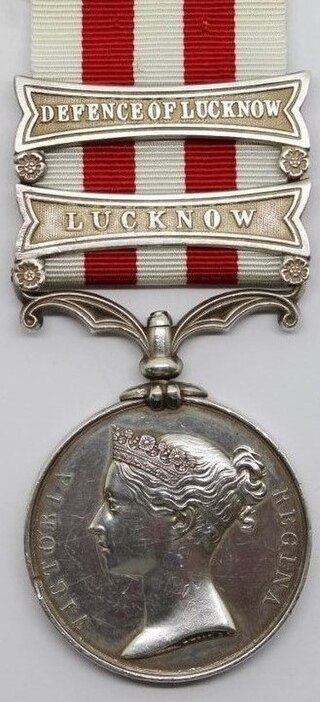
The Indian Mutiny Medal was a campaign medal approved in August 1858, for officers and men of British and Indian units who served in operations in suppression of the Indian Rebellion of 1857.

The Army of India Medal (AIM) was a campaign medal approved in 1851 for issue to officers and men of the British Army and the Army of the Honourable East India Company. A retrospective award following the precedent set by the Naval General Service Medal and the Military General Service Medal, it served to reward service in various actions from 1803 to 1826.

The China War Medal 1900 was a British campaign medal approved on 1 January 1902 for issue to British and Indian land and sea troops who served during the Boxer Rebellion, between 10 June and 31 December 1900. The medal was issued in silver to combatants and in bronze to native, namely Indian, bearers drivers and servants.

The India Medal was a campaign medal approved in 1896 for issue to officers and men of the British and Indian armies.

The East and Central Africa Medal, established in February 1899, was a British campaign medal awarded for minor military operations in the Uganda Protectorate and Southern Sudan between 1897 and 1899. Four separate clasps were issued.
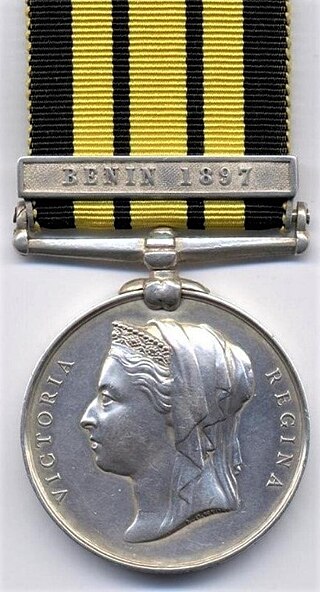
The East and West Africa Medal, established in 1892, was a campaign medal awarded for minor campaigns that took place in East and West Africa between 1887 and 1900. A total of twenty one clasps were issued.
The Army Gold Medal (1808–1814), also known as the Peninsular Gold Medal, with an accompanying Gold Cross, was a British campaign medal awarded in recognition of field and general officers' successful commands in campaigns, predominantly the Peninsular War. It was not a general medal, since it was issued only to officers whose status was no less than that of battalion commander or equivalent.

The Transport Medal was a British campaign medal sanctioned on 8 November 1903 and awarded by the Lord Commissioners of the Admiralty. It was awarded to masters and officers of merchant ships employed by the Transport Service to move troops to either South Africa during the South African War or to China during the Boxer Rebellion. The officers of hospital ships also qualified.

The Canada General Service Medal was a campaign medal awarded by the Canadian Government to both Imperial and Canadian forces for duties related to the Fenian raids between 1866 and 1871. The medal was initially issued in 1899 and had to be applied for. The application period was later extended to 1907, then to 1928.

–

The Ashantee Medal is a British campaign medal instituted on 1 June 1874. It was awarded to British, Colonial and allied native forces, under the command of Major General Sir Garnet Wolseley, who were deployed against the army of the Ashanti King Kofi Karikari, during the Third Anglo-Ashanti War, June 1873 to February 1874.

The Rocky Mountain Rangers were one of the volunteer militia units raised in Canada's North West in response to the 1885 North-West Rebellion. It was a body of mounted irregulars, mostly cowboys and ranchers from the area around Fort Macleod, the headquarters of the North-West Mounted Police (NWMP) at the base of the foothills of the Rocky Mountains, about 150 miles (240 km) west of Medicine Hat. This unit is not to be confused with the present-day Canadian Army Reserve unit The Rocky Mountain Rangers of Kamloops, British Columbia. Rather, it is the ultimate ancestor of the South Alberta Light Horse (SALH).
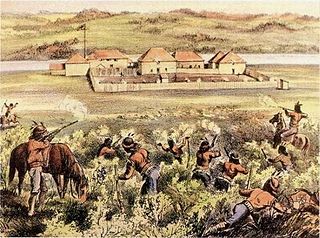
The North-West Mounted Police (NWMP) played a significant role during the North-West Rebellion in Canada in 1885. The NWMP suffered early reverses and, although they supported the relief force sent to the region under the command of Major-General Frederick Middleton, their performance was heavily criticized. Commissioner Acheson Irvine resigned from his command of the police as a result.



















